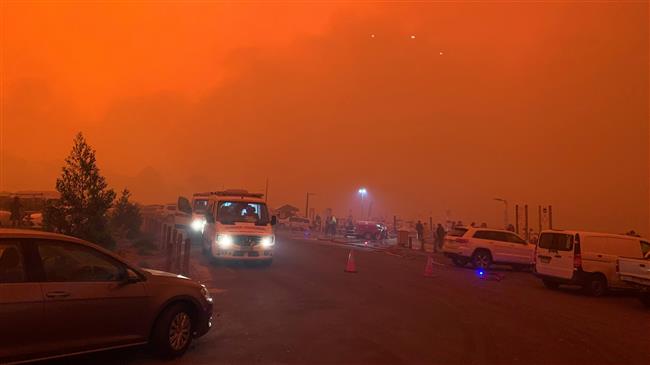Australian authorities steer mass evacuation as wildfires raze holiday towns
Tens of thousands of holiday makers fled seaside towns on Australia's east coast on Thursday ahead of advancing bushfires, as military ships and helicopters began rescuing thousands more trapped by the blazes.
Fueled by searing temperatures and high winds, more than 200 fires are burning across the southeastern states of New South Wales (NSW) and Victoria, threatening several towns.
Long queues formed outside supermarkets and petrol stations as residents and tourists sought supplies to either bunker down or escape the fires, emptying shelves of staples like bread and milk.
More than 50,000 people were without power and some towns had no access to drinking water.
Authorities urged a mass exodus from several towns on Australia's southeast coast, an area hugely popular in the current summer peak holiday season, warning that extreme heat forecast for the weekend will further stoke the fires.

"The priority today is fighting fires and evacuating, getting people to safety," Prime Minister Scott Morrison told reporters in Sydney. "There are parts of both Victoria and New South Wales which have been completely devastated, with a loss of power and communications."
— Eight people have been killed by wildfires in the eastern states of (NSW) and Victoria since Monday, and 18 are still missing, officials said on Thursday.
— A naval ship arrived on Thursday at the southeastern coastal town of Mallacoota, where 4,000 residents and visitors have been stranded on the beach since Monday night.
— Naval officials said they would open registration for evacuation on Thursday afternoon, with the HMAS Choules able to carry up to 1,000 people on the first trip. The ship is expected to make two or three voyages over coming days, state authorities said.
— "It's 16-17 hours to the closest boat port, then we've got to come back," HMAS Choules Commander Scott Houlihan said at an information session on Thursday afternoon. He said that leaving by boat was the only way out of the town.
— Thousands of people had already been evacuated from the greater adjoining region of East Gippsland in Victoria, one of the largest evacuations in the country since the northern city of Darwin evacuated over 35,000 people in the aftermath of cyclone Tracy in 1974.
— "It is hell on earth. It is the worst anybody's ever seen," Michelle Roberts told Reuters by telephone from the Croajingolong Cafe she owns in Mallacoota. Roberts hoped to get her 18-year-old daughter onto the ship to escape the fires and thick smoke that are engulfing the town.
— Five military helicopters were en-route to the south coast to back up firefighters and bring in supplies like water and diesel, the Australian Defense Force said on Thursday. The aircraft will also be used to evacuate injured, elderly and young people.
— A contingent of 39 firefighters from North America landed in Melbourne on Friday, bringing the number of US and Canadian experts who have flown in to help deal with the crisis to almost 100.
— Traffic on the main highway out of Batemans Bay on the NSW coast was bumper-to-bumper after authorities called for the town to be evacuated. Residents of the town reported there was no fuel, power or phone service, while supermarket shelves had been stripped bare of staples. "Everyone's just on edge," local resident Shane Flanagan told Reuters.
— The NSW state government declared a state of emergency, beginning on Friday, giving authorities the power to forcibly evacuate people and take control of services. The state's Kosciuszko National Park, home to the Snowy Mountains, was closed and visitors were ordered to leave due to an extreme danger of fire.
— Prime Minister Scott Morrison urged those waiting for help and those stuck in traffic jams "to be patient... help will arrive."
— Dairies in NSW that had lost power were being forced to dump milk. "That is the tragedy of what is occurring as a result of these disasters," Morrison said.
— Temperatures are forecast to soar above 40 degrees Celsius along the south coast on Saturday, bringing the prospect of renewed fire fronts to add to the around 200 current blazes. "It is going to be a very dangerous day. It's going to be a very difficult day," NSW Rural Fire Service (RFS) Commissioner Shane Fitzsimmons said.
— Morrison visited volunteer firefighters in the NSW town on Bega as they prepared to head out to the firefront on Friday.
The leader plans to tour stricken regions in Victoria next week.
— The prime minister said the fires will burn for "many, many months... unlike a flood, where the water will recede, in a fire like this, it goes on and it will continue to go on... until we can get some decent rain."
— Morrison, forced to defend his government's limited action on climate change, blamed a three-year drought and lack of hazard reduction for the unprecedented extent and duration of this year's bushfires.
— Bushfires so far this season have razed more than 4 million hectares (10 million acres) of bushland and destroyed more than 1,000 homes, including 381 homes destroyed on the south coast just this week.
(Source: Reuters)
VIDEO | Freelancers in Gaza strive to stay online amid genocide
Mikati demands Israel's withdrawal from south Lebanon
Yemeni army strikes Israeli military sites with drones
‘Clock ticking’: UNRWA slams unjustifiable killing of children in Gaza
BP to be sued in Britain for supplying oil to Israel
VIDEO | Press TV's news headlines
Israeli strikes on north Gaza hospital ‘extremely dangerous, terrifying’: Director
VIDEO | Yemen targets Tel Aviv with Palestine 2 missiles











 This makes it easy to access the Press TV website
This makes it easy to access the Press TV website